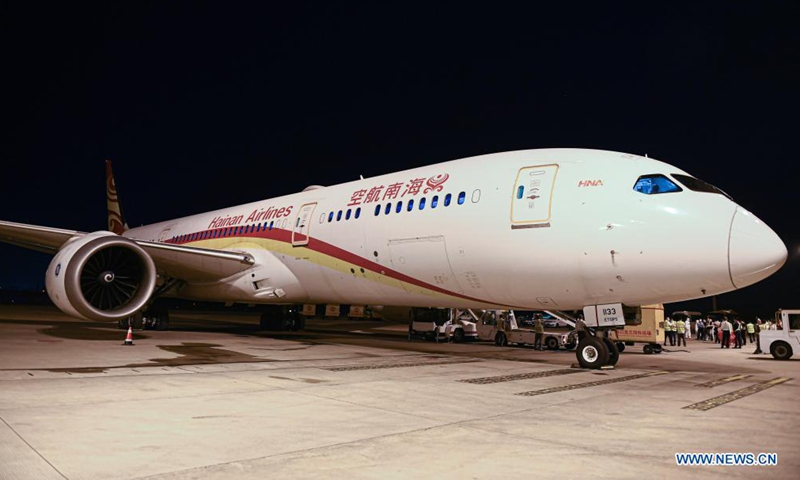China-US air cargo under pressure amid port congestion ahead of holidays
Traders face capacity shortfall, surging prices amid robust demand

A cargo flight of Hainan Airlines is seen at Haikou Meilan International Airport in Haikou, south China's Hainan Province, March 26, 2021. China's southern tropical province of Hainan on Saturday launched a Haikou-Paris air freight route to serve international cargo transport of its free trade port. An outbound cargo flight carrying 35 tonnes of goods left Haikou for Paris on Saturday morning. Photo: Xinhua
As the US continues to grapple with port congestion and other logistics woes ahead of the holiday shopping season, many traders have resorted to what is usually the last shipping option - air cargo. But even the more costly option is now facing a serious capacity shortfall, extended waiting time and surging prices, due to high demand, traders and industry insiders said on Monday.
"Companies don't have much choice, even though air transport costs a lot more than sea transport, because otherwise, they may miss the Christmas selling season," Kang Shuchun, a director of the China Federation of Logistics and Purchasing, told the Global Times on Sunday.
In the face of booming demand, air cargo rates are up 10-20 percent compared with August and September, according to Kang.
However, even with higher prices, traders still face long waiting time to book space for their cargos, if they can find any.
A cross-border logistics agent in Shenzhen, South China's Guangdong Province, said that the current air shipment period from Shenzhen to Los Angeles is around nine to 12 working days, about one week longer than in ordinary times.
"The main reason is the lack of cargo flights between China and US, and transit shipments passing through third countries may take more time," said the agent.
Due to the lack of air cargo capacity, shipments are only loaded at least four to five days after they arrive at the agency's garage in Shenzhen, the Shenzhen-based agent said.
Another trader in Guangzhou surnamed Huang told the Global Times on Monday that she wanted to reserve 15 tons of slots for cargo flights to the US but the airline company could not even promise that.
"I was told that I could only get half of the slots on the plane," Huang said, noting that the demand for Chinese goods in the US has been stronger than at any time of the year, partially due to the shopping season at the year end, combined with logistics hurdles.
Some large enterprises account for most of the use of air cargo space, which may be one of the reasons that capacity has tightened, industry insiders said.
Manufacturers of clothing brands for US-based companies, including Nike and Ralph Lauren and some other shoe brands are using more expensive air freight to bypass congested ports or replenish inventory, Chinese financial media outlet Yicai reported on Monday, based on recent US earnings season call transcripts and other information.
Driven by demand, the number of round-trip cargo flights between China and the US has shown an uptrend since September, industry information provider VariFlight told the Global Times on Monday.
The number of cargo flights from China to the US is about twice the number of cargo flights from the US to China, according to VariFlight.
Wu Minghua, a veteran industry analyst, told the Global Times on Monday that he believes at least one-third of the China-US air cargo capacity is missing, compared with the first half of the year, due to longer waiting times at US ports and booming demand for Chinese goods at the year end.
Amid the capacity shortfall, some airlines are adding more flights.
To improve the logistics network's capacity and strengthen links between the Asia-Pacific region and the US and European markets, FedEx added six intercontinental routes that are experiencing high demand, the company said in a statement sent to the Global Times on Monday.
With the addition of the new routes, FedEx has more than 225 flights in and out of the Asia-Pacific region each week, which is expected to provide stronger logistics support for the shopping season at the year end, the company said.
But the situation is expected to ease in February as demand and supply gradually return to normal, Kang said.



